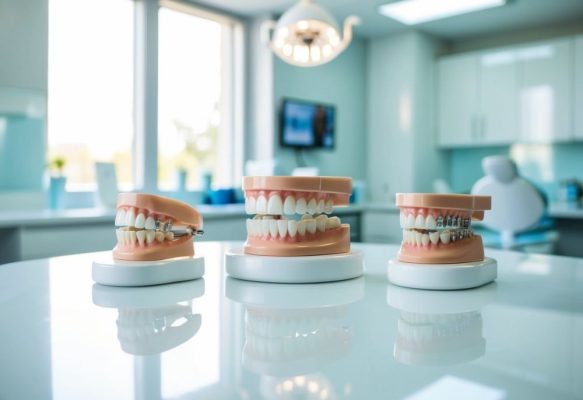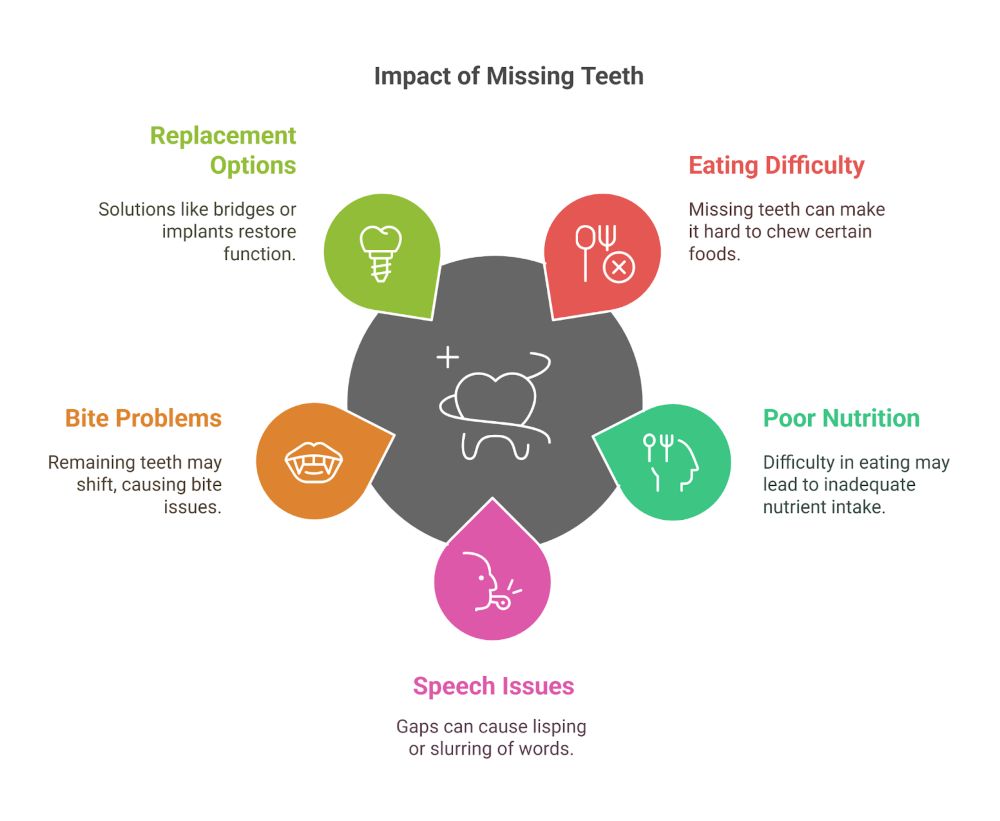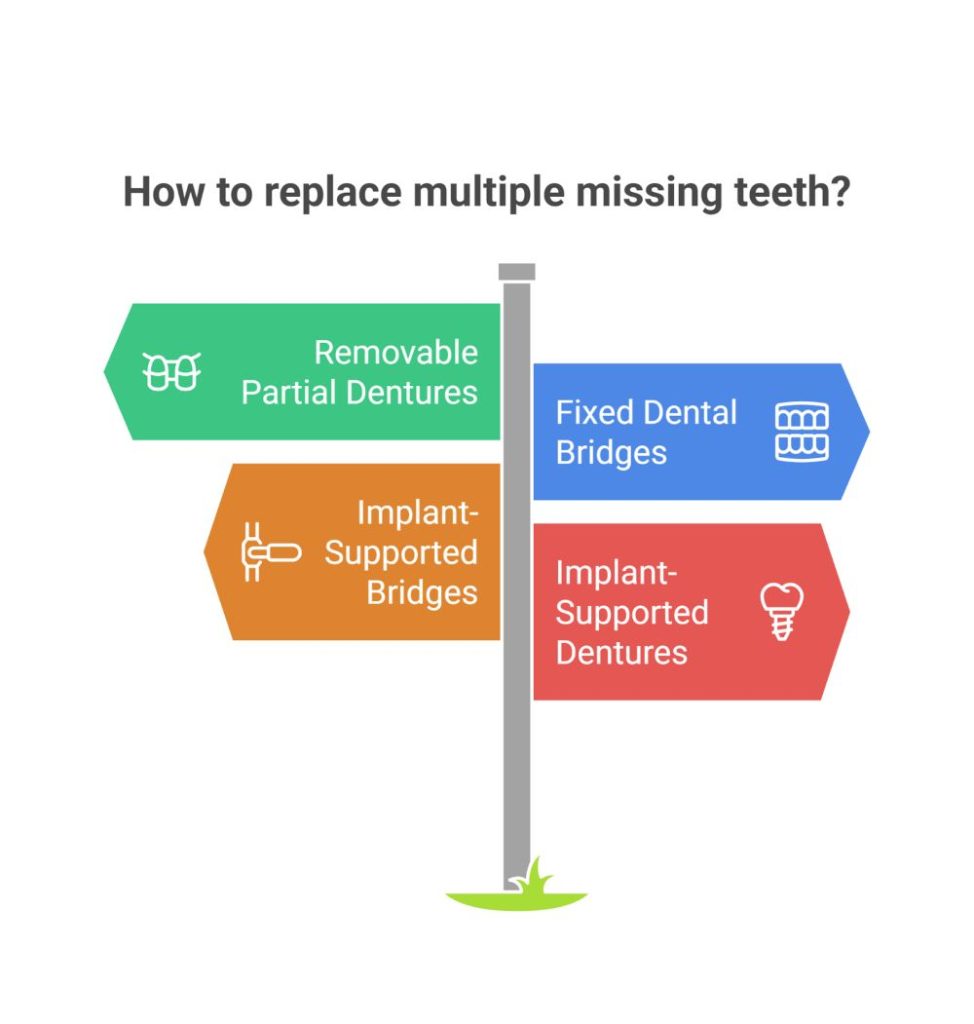
Comprehensive Guide to Multiple Tooth Replacement Options: Dentures, Bridges, and Implants Explained
Last Updated: February 6, 2025 2:06 am | Medically Reviewed by Dr. Michael Berglass, DDS

Losing multiple teeth can significantly impact your smile, self-confidence, and overall oral health.
Fortunately, modern dentistry offers several effective solutions for replacing missing teeth.
Dental implants, bridges, and dentures are the primary options available for restoring your smile and bite functionality.
Each tooth replacement method has its own advantages and considerations. Dental implants provide a permanent, natural-looking solution that can last a lifetime with proper care.
Meanwhile, bridges offer a fixed option for replacing one or more adjacent missing teeth. On the other hand, dentures are removable appliances that can replace multiple teeth or even a full arch.
Choosing the right replacement option depends on factors such as the number of missing teeth, the health of the jawbone, and personal preferences.
It’s important to consult with a dentist to determine the best solution for your unique situation.
With the right approach, patients can regain a beautiful, functional smile and improved quality of life.

Missing teeth can lead to serious problems if left untreated. These issues affect oral health, daily function, and emotional well-being.
Not replacing missing teeth can cause nearby teeth to shift and become misaligned. This makes cleaning harder and increases the risk of decay and gum disease.
Meanwhile, bone loss in the jaw is another major concern. Without tooth roots to stimulate it, the jawbone starts to shrink. This can change facial structure and make a person look older.
Dental implants help prevent bone loss by mimicking natural tooth roots. They keep the jawbone strong and healthy.
Missing teeth can make it difficult to eat certain foods, which can lead to poor nutrition and digestive issues.
Speech can also be affected. Gaps in teeth can cause lisping or slurring of words.
Meanwhile, bite problems may develop as the remaining teeth shift. This can lead to jaw pain and headaches.
Replacement options like bridges or implants restore normal eating and speaking ability.
A gap-toothed smile can hurt self-esteem. Many people feel less confident in social and professional settings.
Some people avoid smiling or laughing to hide their missing teeth, which can affect their relationships and quality of life.
Replacing missing teeth can boost confidence and improve mental health. Modern options like implants look and feel natural.
Addressing tooth loss early prevents these issues. It helps maintain oral health, function, and well-being.
Losing multiple teeth? Don’t let it affect your confidence and health! West Palm Beach Family Dental offers dental implants, bridges, and dentures to restore your smile. Book your consultation today and reclaim your bite!
If you’re ready to get started, call us now!

Losing multiple teeth can affect your smile and ability to eat. There are several ways to replace missing teeth, each with its own pros and cons. These options aim to restore function and appearance.
Removable partial dentures are a common choice for replacing multiple missing teeth. They consist of artificial teeth attached to a plastic base that matches your gum color. Metal clasps help hold the denture in place.
These dentures can be taken out for cleaning and while sleeping. They’re less expensive than other options. However, they may feel bulky and take time to get used to.
Partial dentures can improve chewing and speaking. They also help maintain the shape of your face. But they may need adjustments or replacements over time.
Fixed dental bridges are another option for multiple tooth replacement. They’re made of artificial teeth fused between two crowns. The crowns are placed on the teeth next to the gap.
Bridges are permanent and cannot be removed. They look and feel natural and are more stable than removable dentures.
Getting a bridge doesn’t require surgery and is usually faster than getting implants. However, healthy teeth need to be filed down for the crowns.
With proper care, bridges can last 5-15 years. They help prevent remaining teeth from shifting. Regular brushing and flossing are important to keep the bridge clean.
Implant-supported bridges combine dental implants with bridges. They’re used when there are three or more missing teeth in a row. Implants are placed in the jawbone to support the bridge.
This option doesn’t rely on natural teeth for support. It helps preserve bone in the jaw. Implant-supported bridges look and function like natural teeth.
The process takes longer than traditional bridges. It involves surgery to place the implants. But the result is often more stable and long-lasting.
These bridges can improve chewing ability and speech. They also help maintain facial structure. With proper care, they can last many years.
Implant-supported dentures combine the benefits of implants and dentures. They’re a good choice for people missing all teeth in the upper or lower jaw. Implants in the jawbone support a full denture.
These dentures are more stable than traditional ones. They don’t slip or move when eating or speaking. This improves comfort and confidence.
Implant-supported dentures preserve jawbone better than regular dentures. They can be fixed or removable. Fixed ones stay in place and are brushed like natural teeth.
The implant process takes several months. But many find the result worth the wait. These dentures can greatly improve the quality of life for those missing many teeth.
Dental technology has made significant strides in recent years. New materials, techniques, and digital tools make tooth replacement more effective and comfortable for patients.
Digital technologies have revolutionized tooth replacement planning. Dentists now use 3D scans to create detailed models of a patient’s mouth.
These models allow for precise implant placement planning. 3D printing is also used to make surgical guides, which help dentists place implants with high accuracy.
CAD/CAM systems can be used to design and fabricate custom prosthetics. This results in better-fitting replacements that look and feel more natural.
Traditionally, patients had to wait months for implants to heal before attaching replacement teeth. Immediate loading implants have changed this.
These implants allow temporary teeth to be attached right after surgery. Thus, patients can leave the dentist’s office with a functional smile on the same day.
The implants are designed to handle immediate force while still fusing with the bone. This technique can greatly reduce treatment time and improve patient satisfaction.
New materials are making implants stronger and more biocompatible. Zirconia implants, a metal-free option, may be better for some patients.
Meanwhile, titanium alloys have been improved to increase strength and reduce the risk of implant failure. Some implants now have special coatings that promote faster bone integration.
Nanostructured surfaces on implants can enhance osseointegration. This leads to quicker healing and a more stable long-term result.
Your smile deserves the best solution! Whether you need implant-supported bridges, dentures, or a custom dental plan, West Palm Beach Family Dental has you covered. Schedule your appointment now and explore your options!
If you’re ready to get started, call us now!
Several key factors influence the choice of tooth replacement. These include current oral health, budget constraints, personal preferences, and lifestyle considerations.
Your oral health plays a big role in determining suitable replacement options. The condition of your remaining teeth, gums, and jawbone affects what’s possible.
Good bone density is needed for dental implants. If you lack enough bone, grafting may be required first.
Gum disease must be treated before any replacements. This helps ensure long-term success.
The number and location of missing teeth also matter. A single missing tooth has different options than multiple gaps.
Your dentist will assess your oral health to recommend appropriate choices.
Cost is often a major factor when choosing tooth replacements. Different options have varying price points.
Dental implants are usually the most expensive choice. They can cost $3,000-$4,500 per tooth.
Meanwhile, bridges are mid-range, typically $2,000-$5,000 for a three-unit bridge.
Finally, dentures are generally the least expensive option. A full set may cost $1,000-$3,000.
Check your dental insurance coverage. Some plans may cover part of the cost for certain procedures.
Payment plans or financing options might be available to help manage costs.
Your personal wants and needs play a big role in choosing a replacement option. Some people prefer the permanence of implants, and others like dentures because they can be removed.
Aesthetics matter, too. Implants and bridges often look most like natural teeth.
Consider how each option might affect your speech and eating habits.
Think about long-term maintenance, too. Implants require regular brushing, while dentures need nightly cleaning.
Discuss your preferences with your dentist to find the best fit.
Your daily life and habits influence which replacement option works best. Active people might prefer fixed options like implants or bridges. These don’t need to be removed for sports.
Smokers may not be good candidates for implants. Smoking can interfere with healing.
Your age matters, too. Younger patients might lean towards long-lasting implants.
Diet affects your choice. Denture wearers may need to avoid certain hard or sticky foods.
Consider your job. Public speakers might prefer fixed options for clear speech.
Your comfort with dental procedures is important. Implants require surgery, while dentures don’t.
Getting implant-supported tooth replacements involves several steps. The process takes time but results in a durable, natural-looking solution for missing teeth.
The journey starts with a visit to the dentist. During this appointment, the dentist examines the patient’s mouth and takes X-rays. They also check the health of the gums and remaining teeth and examine the bone density in the jaw.
This exam helps determine whether implants are a good option. The dentist asks about the patient’s medical history and medications and discusses the patient’s goals and expectations.
If implants seem suitable, the dentist explains the process. They talk about costs, timelines, and potential risks. This helps patients make an informed choice about their treatment.
After deciding to proceed, the dentist creates a treatment plan. This plan is custom-made for each patient’s needs. It outlines the number of implants needed and their placement.
The dentist may use 3D imaging to map out implant locations. This ensures precise placement and avoids nerves or sinuses. Some patients may need other procedures first, like bone grafts or tooth extractions.
The plan also includes the type of restoration to be used. These could be crowns, bridges, or implant-supported dentures. The dentist discusses care instructions and sets up appointment dates.
Implant surgery is usually an outpatient procedure. The dentist numbs the area with local anesthesia. For anxious patients, sedation may be an option.
The dentist makes a small cut in the gum to expose the bone. They then drill a hole and place the implant. The gum is stitched closed over the implant.
For multiple implants, this process is repeated. Some patients may get all implants in one day. Others might need several appointments.
After surgery, the healing process begins. This phase is crucial for implant success. The bone grows around the implant, securing it in place. This process is called osseointegration.
Healing typically takes 3 to 6 months. During this time, patients eat soft foods to protect the implant sites and practice good oral hygiene to prevent infection.
The dentist monitors progress with check-ups to ensure that healing is on track. Once osseointegration is complete, the implants are ready for the final step.
The last step is attaching the artificial teeth. The dentist reopens the gum to expose the implant. They attach a small connector called an abutment.
Next, they take impressions of the mouth. These are used to create the final restoration. This could be a crown, bridge, or full denture.
Once ready, the dentist attaches the restoration to the abutments. They check the fit and bite. Minor adjustments ensure comfort and proper function. With care, these implant-supported solutions can last many years.
Proper maintenance of tooth replacements is key to their longevity and oral health. It helps prevent problems and keeps your smile bright.
Brushing is vital for tooth replacements. Use a soft-bristled toothbrush and non-abrasive toothpaste. Brush at least twice daily, paying extra attention to the gum line.
For dentures, remove and clean them after meals. Soak them overnight in a denture cleaner. Brush dentures gently to remove food and plaque.
Flossing is crucial for bridges and implants. Use floss threaders or interdental brushes to clean under and around bridges. Special floss or water flossers work well for implants.
Rinse with an antibacterial mouthwash to reduce bacteria and freshen your breath.
Dental check-ups are essential for maintaining tooth replacements. Schedule visits every 6 months or as recommended by the dentist.
During these visits, the dentist will:
For implants, x-rays may be taken to check bone levels and implant stability.
Report any discomfort or changes in fit promptly. Early detection of issues can prevent bigger problems.
Diet plays a role in caring for tooth replacements. Avoid hard or sticky foods that could damage dentures or bridges.
For implants, limit sugary and acidic foods. These can lead to decay around the implant.
Quit smoking to protect oral health. Smoking can stain replacements and increase the risk of gum disease.
Wear a mouthguard during sports to protect bridges and implants from damage.
Avoid using teeth as tools. Don’t open packages or bite nails with replacements.
Stay hydrated to maintain good saliva flow. This helps clean the mouth and protect against decay.
A strong, healthy smile is just one step away! At West Palm Beach Family Dental, we specialize in long-lasting multiple-tooth replacements tailored to your needs. Call us today and start your journey toward a complete smile!
What are the types of dental implants and how do they differ?
Dental implants come in different types. The main ones are endosteal and subperiosteal implants.
Endosteal implants are the most common type and work well for most patients. They are placed directly into the jawbone.
Subperiosteal implants sit on top of the bone but under the gum. These are used when patients don’t have enough healthy jawbones for endosteal implants.
What are the potential complications associated with dental implant surgery?
Dental implant surgery can have some risks. Infection at the implant site is one possible issue.
Pain and swelling may occur after the procedure. In rare cases, nerve damage can happen, causing numbness or tingling.
Sometimes, the body rejects the implant. This is not common but can require removal of the implant.
How do dentures, bridges, and implants compare in terms of cost-effectiveness?
Dentures are often the least expensive option upfront. They can be a good choice for those on a tight budget.
Bridges fall in the middle range for cost. They last longer than dentures but may need replacement after several years.
Implants have the highest initial cost. But they can last a lifetime with proper care, making them cost-effective in the long run.
What factors influence the choice between a dental bridge and an implant?
The health of nearby teeth is a key factor. Bridges require altering adjacent teeth, while implants don’t.
Bone density in the jaw matters as well. Implants need sufficient bone to hold them in place.
Cost and insurance coverage often play a role. Some plans may cover bridges but not implants.
Time is also important. Bridges can be placed faster, while implants require months of healing.
What are the long-term maintenance considerations for dentures, bridges, and implants?
Dentures need regular cleaning and may require adjustments or replacements over time. They should be removed and cleaned daily.
Bridges require careful brushing and flossing to keep the supporting teeth healthy. Special floss or brushes may be needed.
Implants need regular brushing and flossing like natural teeth. They may need periodic check-ups to ensure they’re still secure.
How does the loss of a side tooth affect oral health, and what replacement options are recommended?
Losing a side tooth can cause nearby teeth to shift, which can lead to bite problems and make cleaning harder.
It can also affect chewing ability and put extra stress on other teeth.
For side tooth replacement, dental implants are often recommended. They prevent bone loss and keep other teeth stable.
Bridges are another good option. They are especially helpful if nearby teeth need crowns. Partial dentures can work but may be less comfortable for chewing.